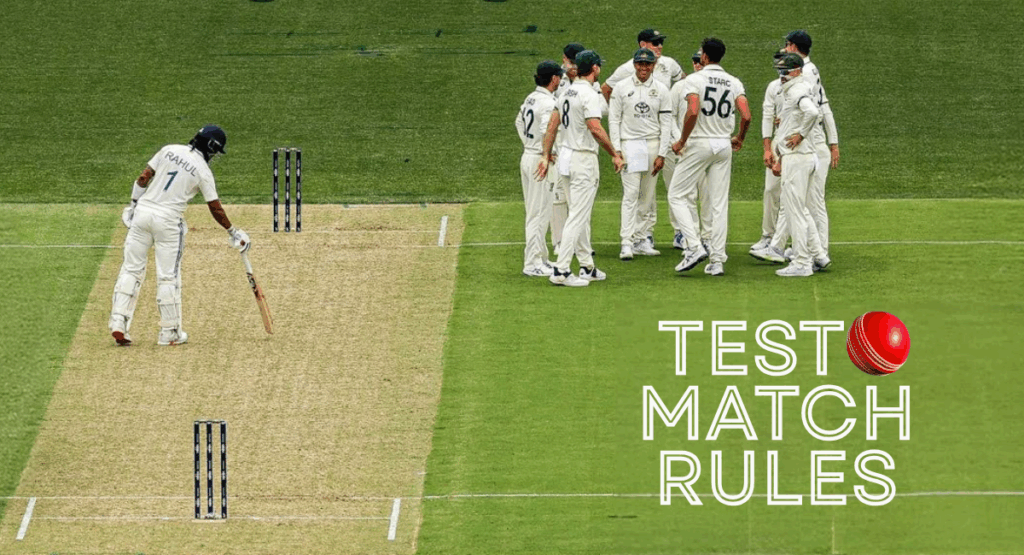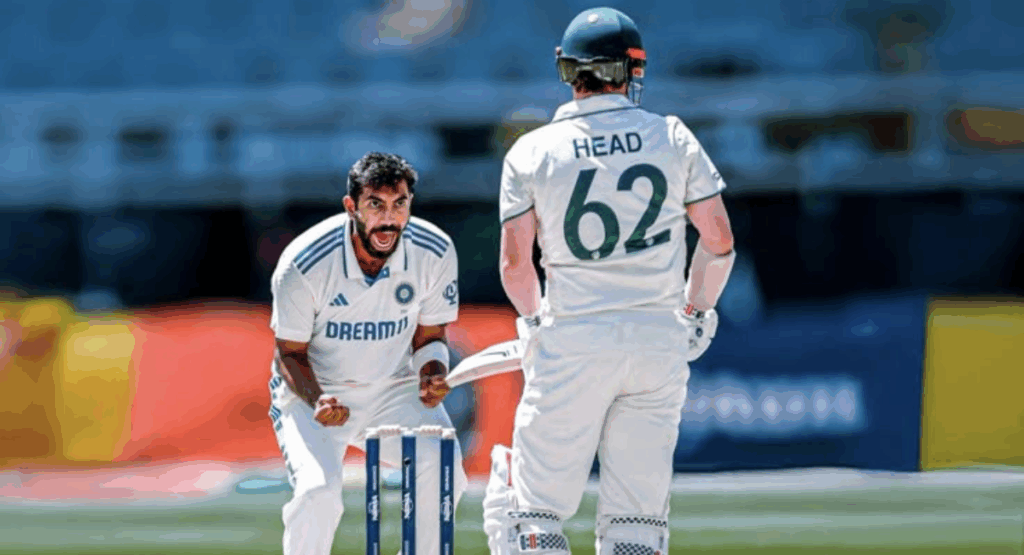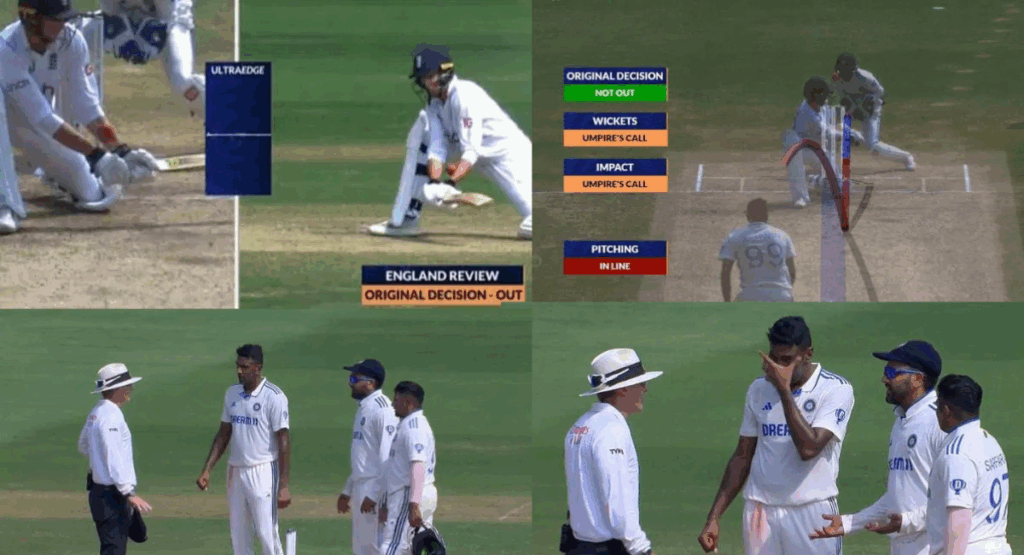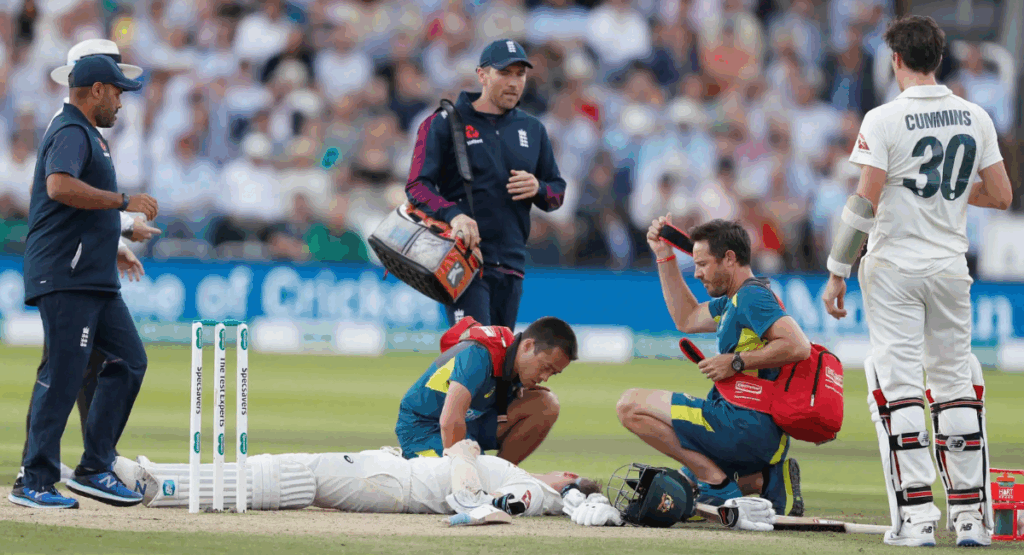Let’s be honest, if you’re used to the fast thrills of T20s or ODIs, Test cricket can feel a bit puzzling at first. Here’s the beauty of it: Test cricket is the heart and soul of the sport. That’s why understanding the Test Cricket Rules is so important. They don’t just explain the game; they unlock the excitement, the tactics, and the patience behind every session. Whether you’re watching your very first Test or looking to deepen your love for the format, this Test cricket rules guide will help you enjoy it all the more.

What Is Test Cricket?
Test cricket is played between two international teams over five days. Yes, five full-day formats with each team getting two chances to bat and bowl. At the beginning of the match, a coin toss determines which team will bat first. The batting team aims to set a solid score in their first innings. After that, they switch to bowling, hoping to get the opposing team out for fewer runs. After that, the cycle repeats in the second innings. It sounds simple, but over five days, pitch conditions change, weather shifts, and player fatigue set in. That’s where strategies, timing, and mental strength come into play.
Why Is Test Cricket Unique?
In contrast to T20 matches, where a game can flip in just a few explosive overs, Test cricket demands that you earn your victory through steady, consistent play. A single session of poor performance can turn the tide, but a determined comeback can change everything. That’s where the real excitement lies. Plus, teams aren’t just focused on winning; they also have to strategize to avoid losing. This adds a depth of strategy that you often don’t see in the shorter formats.
1. Core Test Cricket Rules
1.1 How Scoring Works
Scoring in Test cricket works the same way as other formats; runs are the primary goal. Batters can:
- In cricket, the batting team racks up runs by either sprinting between the wickets or smashing the ball to the boundary.
- If the ball touches the ground before it crosses the boundary line, that’s worth 4 runs; but if it sails over without touching down, it’s 6 runs.
- The score is further influenced by extras like leg-byes, byes, wides, and no-balls.
Extras include:
- No-balls: an illegal delivery (overstepping the crease).
- Wides: bowled too far from the batter.
- Byes and leg byes: when the batter doesn’t hit the ball but still manages a run.
1.2 Overs & Bowling
Each over contains six legal balls. Once an over is completed, a new bowler comes in from the opposite end of the pitch. No bowler can bowl more than 10 overs from the same end. Teams usually rotate their bowlers using fast bowlers in short, fiery spells and spinners for control. Over the five days, the pitch can deteriorate, which makes spin bowling more effective. If you’re new to watching, keep an eye on the number of overs left in the day; it helps gauge the pressure.
1.3 Dismissal Methods
There are several ways a batter can be dismissed, and knowing them adds depth to your viewing.
- Bowled: The ball hits the stumps directly.
- Caught: A fielder or keeper catches the ball before it touches the ground.
- LBW (Leg Before Wicket): If the ball hits the batter’s pad and hits the stumps.
- Run Out: A fielder breaks the stumps before the batter completes the run.
- Stumped: The batter steps out of the crease and misses the ball.
- Hit Wicket: The batter knocks down their stumps.
- Handled the Ball: Batter touches the ball with a hand not holding the bat.
- Obstructing the Field: Batter deliberately blocks fielders with the body or bat.
- Hit the Ball Twice: The Batter hits the ball more than once on purpose.
- Timed Out: The next batter doesn’t show up within two minutes of the last wicket.
These rules may seem complex at first, but once you watch a few matches, they’ll become second nature.
1.4 No Field Restrictions
Here’s something different from ODIs and T20s. Test matches have no fielding restrictions. That means the captain can place fielders wherever they want, based on strategy and conditions. You’ll often see attacking setups like three or four slips (fielders behind the batter) when a bowler is trying to take wickets. On the flip side, defensive fields have more players spread across the boundary to prevent runs. Captains must read the game carefully and adjust fielders constantly.

2. How a Test Match Is Won
A team wins a Test match if it scores more runs across its two innings and successfully dismisses the opposing team twice. But here’s the twist: if time runs out before both innings are completed, the match is declared a draw. Not a tie, just… unfinished. It’s part of what makes the game so fascinating. Teams can either push hard to win or dig in and fight for survival. A tie, however, is quite a rare occurrence. It happens only when both teams end up with the same number of runs after finishing all their innings.
3. Follow-On Rule
The follow-on is one of Test cricket’s most strategic elements. If Team A bats first and leads Team B by 200 or more runs after the first innings, they can ask Team B to bat again immediately. This is called enforcing the follow-up.
It’s a way to apply pressure, especially when the pitch deteriorates or rain might wash out the remaining days. However, it’s a double-edged sword. If the second team performs strongly in their follow-on innings, they could pull off an incredible comeback.

4. Declarations & Forfeiture
Unlike other formats, the batting team in a Test match can declare their innings closed whenever they want. Let’s say they’ve scored enough runs and want more time to bowl the opponent out. The captain can declare and give the bowlers a chance to force a result. In rare situations, a team may even forfeit an innings, completely skip it, to try and manufacture a result. It’s risky, but it’s legal.
5. Daily Match Structure
Each Test day is divided into three sessions:
- Morning (local time, differs by country)
- Afternoon (local time, differs by country)
- Evening (local time, differs by country)
Between these are two breaks: lunch (40 minutes) and tea (20 minutes). Each day aims to cover 90 overs. If rain or bad light disrupts play, extra time can be added to catch up. Test cricket, after all, is about adapting to nature and time.

6. Decision Review System (DRS)
Even the best umpires make mistakes. That’s where DRS comes in. Each team gets two reviews per inning. They can use them to challenge on-field umpire decisions, like LBWs or catches. With DRS, technology plays a major role:
- Ball tracking illustrates where the ball is expected to go.
- UltraEdge detects tiny edges through sound.
- HotSpot uses infrared to show ball contact.
If the review goes well, the team will hold onto it. If not, they lose it. Smart use of DRS often changes the course of the game.
7. Field Placements & Tactical Play
In Test cricket, the way players are positioned on the field is just as crucial as how they bowl or bat. Captains often rely on close-in fielders, such as:
- Slips – Stand next to the wicketkeeper to catch edges.
- Gully – Between slips and a point to catch thick edges.
- Silly Point – Very close on offside to catch soft shots.
- Short Leg – Very close on the leg side for quick catches.
- Long On – A long hit towards the leg side, close to the boundary.
- Long Off – Far on offside near the straight boundary.
- Deep Square Leg – Far on leg side, square to the batter.
These positions are designed to catch edges or force mistakes. On the other hand, when a batter settles in, the captain may pull fielders back to protect boundaries. This constant tactical chess makes Test cricket gripping, even when the scoreboard doesn’t move fast.
8. Player Roles & Responsibilities
Every player in a Test team has a distinct role:
- Openers face the toughest challenge from fast bowlers with a new ball.
- Middle-order batters are the backbone, building or saving the innings.
- All-rounders offer balance with both bat and ball.
- Bowlers, whether pace or spin, work in partnerships to break through.
- Wicketkeepers need sharp reflexes and great focus behind the stumps.
Team combinations vary based on the pitch, weather, and opponent.
9. Players’ Code of Conduct
Cricketers should always show respect to everyone on the field: Players are expected to behave politely with umpires, teammates, opponents, and even fans. Arguing or showing anger isn’t acceptable in the spirit of the game.
Bad behavior like shouting, abusing, or over-appealing is not allowed: Using rude language, trying to annoy opponents (sledging), or constantly appealing just to pressure the umpire can lead to punishment like a fine or suspension.
The ICC has clear rules for what’s okay and what’s not: The International Cricket Council (ICC) has a Code of Conduct that lists different types of bad behavior and what the consequences are, whether it’s a warning, a fine, or a ban, depending on how serious it is.

10. Test Cricket Recent Rule Changes
Concussion Substitutes:
- If a player gets hit on the head and shows signs of a concussion, they can be replaced during the match.
- The substitute must be a like-for-like player (for example, a batter for a batter or a bowler for a bowler).
- This rule was introduced to put player health first. It also ensures teams don’t suffer an unfair disadvantage if a key player gets injured.
Soft Signal Removed (Since 2023):
- Earlier, on-field umpires had to give a “soft signal” when a catch was referred to the third umpire; this was their on-field guess.
- Now, the soft signal has been removed. The third umpire can make a decision completely based on video replays.
- This avoids confusion and removes the pressure on on-field umpires to make tough calls on unclear catches.
Saliva Ban:
- Players can no longer use saliva to shine the cricket ball, a practice that was common for swing bowling.
- This rule started during the COVID-19 pandemic as a health precaution and is now a permanent law.
Conclusion
Test cricket isn’t just a sport; it’s a fierce contest of talent, determination, and clever tactics. Once you understand its rules and rhythms, it becomes deeply engaging. So next time you watch a Test match, look beyond the scoreboard. Watch the field changes, feel the pressure of long innings, and enjoy the quiet drama that builds over days. Because in Test cricket, every run tells a story, and now, you know how to read it.
FAQs: Test Cricket Rules
What is the duration of a Test match?
Test cricket is designed to test skill, patience, and endurance. The duration of a five-day format allows for changing conditions, complex strategies, and comeback opportunities, making it the ultimate test of a team’s strength.
Can a Test match end without a winner?
Yes. If both teams don’t complete their innings within five days, the match is declared a draw. It’s not a tie, just unfinished. Ties are extremely rare and happen only when scores are exactly equal after both innings.
What is special about the follow-on rule?
The follow-on is a clever strategy. If one team leads by 200+ runs in the first innings, they can make the other team bat again immediately. It’s used to save time or take advantage of worsening pitch conditions.
What is a ‘declaration’ in Test cricket?
A captain can end the team’s batting innings early if they feel they’ve scored enough runs and want more time to bowl out the other team. It’s a bold and strategic move to push for a win.
Are there limits on fielding positions, similar to those in T20s or ODIs?
Nope! In Test cricket, captains have full freedom to place fielders anywhere. This allows for creative, attacking fields, such as multiple slips or defensive spreads, depending on the game situation.
How do batters usually get out?
The most frequent dismissals are caught, bowled, LBW, and run out. However, there are also rare instances, such as hit wicket, obstructing the field, or being timed out.
What does the Decision Review System (DRS) do?
DRS helps teams challenge wrong umpire decisions using technology like ball-tracking and UltraEdge. Each team gets two reviews per inning, but they lose one if the decision doesn’t get overturned.

